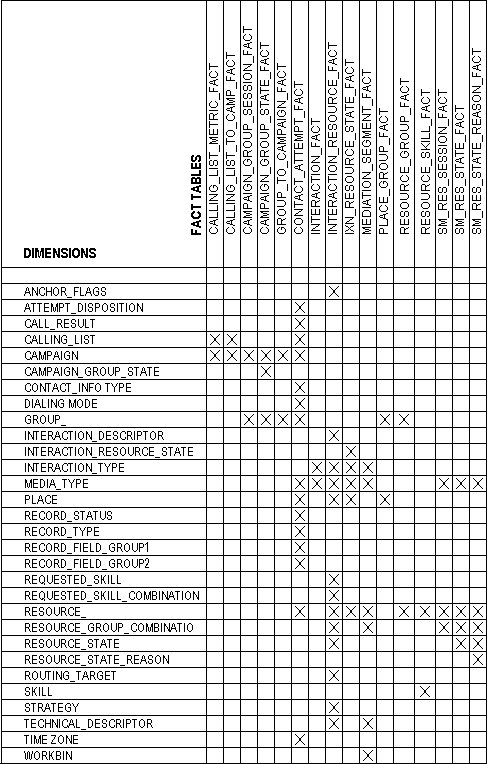Interaction Database
Also known as IDB. The database that stores data about contact-center interactions and resources at a granular level of detail.
See also
Interaction Concentrator.
Glossary
Interaction Concentrator
Also known as ICON. A Genesys product that collects and stores detailed data from various sources in a contact center that is empowered by using Genesys software. Downstream reporting systems can access Interaction Concentrator data in near–real time.
Operating on top of Genesys Framework, the product consists of a server application that is called ICON and a database that is called Interaction Database (IDB). The server receives data from data sources such as Configuration Server, T-Server, or particular Genesys solutions; it then stores this data in IDB by using Genesys DB Server.
Glossary
Genesys Info Mart Overview
Genesys Info Mart produces a data mart that you can use for contact center historical reporting. The data mart includes a server component, administration graphical user interface (GUI), and database. The Genesys Info Mart server runs a set of predefined jobs to:
- Extract data that has been gathered by Interaction Concentrator from data sources such as Configuration Server, T-Server, Interaction Server, and Outbound Contact Server. Genesys Info Mart stores this low-level interaction data, which is consolidated from Genesys Interaction Concentrator databases (Interaction Databases [IDBs]), in the Info Mart database.
- Transform the low-level interaction data and load it into a dimensional model (or star schemas) in the Info Mart database.
Genesys Info Mart can also be configured to host an aggregation engine that aggregates or re-aggregates the data, and populates Aggregate tables in the Info Mart database. You query the fact and dimension tables in the dimensional model, using Structured Query Language (SQL), to obtain results that enable you to examine the data in detail, identify patterns, and predict trends for your organization.
Genesys Info Mart uses multidimensional modeling to create a constellation of star schemas. These star schemas create a database for storing contact center data that can be retrieved using queries. Star schemas support queries that speed the retrieval of the stored data. Querying the data helps you uncover trends, chart heavy usage times, and reveal patterns in your contact center. In this way, Genesys Info Mart can help you:
- Determine how to measure the efficiency of your contact center in comparison with targeted service goals.
- Determine how best to staff your contact center.
- Understand customer preferences and problem trends.
Info Mart Data
Genesys Info Mart 8.x extracts data from one or more IDBs and produces a data mart for contact center historical reporting. Genesys Info Mart yields data that is read-only and historical (representing some period of time).
The Info Mart database consists of the Global Interaction Database (GIDB) tables, fact and dimension tables (dimensional model), Merge tables (used for voice interactions only), Control tables, Staging tables, and Temporary tables.
This guide focuses on the fact and dimension tables, as they are the primary sources of reporting data.
Fact Tables
Fact tables are the large tables in the middle of a star schema. They represent business measures — for example, how long customers waited in a queue, how long and how often agents put customers on hold, or how long agents talked to customers.
Fact tables are surrounded by a set of slowly changing dimension tables. Fact tables represent a many-to-many relationship between dimensions; that is, there are many facts in a single fact table, and they are related to many dimensions in various dimension tables. Fact tables reference dimensions by using surrogate key columns.
Dimension Tables
Dimension tables describe the attributes of the associated fact table. For example, the dimensions that are related to interactions might include the date and time when each interaction started, the required skills for various service types requested by customers, and the value of various customers to the business.
Data Aggregation
An aggregation engine creates Aggregation tables and aggregates data in environments in which either the Genesys historical reporting presentation layer (Genesys CX Insights [GCXI]) or the Reporting and Analytics Aggregates (RAA) package are deployed. These Aggregate tables are documented in the Physical Data Model Documentation for your RDBMS.
Subject Areas
Genesys Info Mart contains several subject areas that are of interest for contact center historical reporting — for example, the Interaction, Mediation Segment, or Resource Group subject area. Each subject area is a star schema. For more information about the subject areas and about the fact and dimension tables that are contained in each subject area, refer to the Genesys Info Mart Physical Data Model for your RDBMS.
Facts and Dimensions Matrix
The figure below maps the relationships between Genesys Info Mart fact tables and dimensions in a bus matrix. The bus matrix represents the dimensionality of fact tables in Genesys Info Mart as consolidated tabular views, enabling you to see the full dimensionality of each fact table easily.
Fact table names are listed in columns in the matrix; dimensions are listed in rows. Click the caption below the figure to enlarge.
The matrix excludes the TENANT and DATE_TIME dimensions, which map to all fact tables. It excludes the media-specific interaction and interaction resource tables, as well as the CTL_AUDIT_LOG table.

For information about all the fields that make up the facts and dimensions, refer to the Genesys Info Mart Physical Data Model for your RDBMS. For information about aggregates, see the Physical Data Model Documentation for your RDBMS.
See also Terminology for some important clarifications about terms used in this guide.

